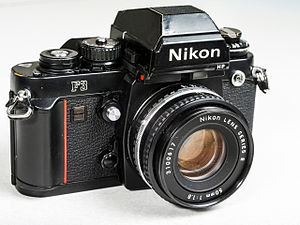This article needs additional citations for verification. (March 2014) |
 | |
| Overview | |
|---|---|
| Maker | Nikon (Nippon Kogaku K. K.) |
| Type | 35mm SLR |
| Released | March 1980 |
| Production | 1980-2001 |
| Intro price | $1,174.90 With 50mm Nikkor f/1.4 (1981)[1] |
| Lens | |
| Lens mount | Nikon F-mount |
| Compatible lenses | Nikon F-mount lenses supporting automatic indexing (AI) with some exceptions; F3 dedicated auto-focus lenses |
| Sensor/medium | |
| Film format | 35 mm |
| Film size | 36 mm × 24 mm |
| Film advance | manual; automatic with optional motor drive |
| Film rewind | manual; automatic with optional motor drive |
| Focusing | |
| Focus modes | manual |
| Exposure/metering | |
| Exposure modes | Aperture priority, manual |
| Exposure metering | silicon photodiode light meter, TTL metering, EV 1 to EV 18 (f/1.4 at 1s to f/16 at 1/1000s at ASA/ISO 100 and with 50 mm f/1.4 lens |
| Metering modes | 80 percent centerweighted[2] |
| Flash | |
| Flash | hot shoe; synch terminal |
| Flash synchronization | 1/80s |
| Compatible flashes | Dedicated F3 accessory shoe mounted flashes with TTL capability; other hot shoe type flashes with adapter; non-hot shoe flashes with synch cord |
| Shutter | |
| Shutter | electronically controlled |
| Viewfinder | |
| Viewfinder | interchangeable eye-level pentaprism |
| General | |
| Made in | Japan |
| Chronology | |
| Successor | Nikon F4 |
The Nikon F3 is Nikon's third professional single-lens reflex camera body, preceded by the F and F2. Introduced in March 1980, it has manual and semi-automatic exposure control whereby the camera would select the correct shutter speed (aperture priority automation). The Nikon F3 series cameras has the most model variations of any Nikon F camera. It is also the first of numerous Nikon F-series cameras to be styled by Italian designer Giorgetto Giugiaro,[3] and to include a red stripe on the handgrip – a feature that would later become (with variants of stripes and various other shapes) a signature feature of many Nikon cameras.
The F2AS was a current model when the F3 was introduced, and for a while both were sold concurrently. The earlier Nikons had developed such a sterling reputation for extreme ruggedness and durability that many Nikon F and F2 owners were initially reluctant to transition to the new F3 from the F2 series, particularly due to the new camera needing batteries to operate. The F3 was superseded by the F4 in 1988 and the F5 in 1996. Despite being superseded by the newer cameras, it remained in production through to 2001, with over 751,000 F3s produced through September 1992. It continues to be the longest running professional grade Nikon SLR. Long after production ceased, new bodies in boxes were available throughout the world, so an exact production number is not readily available.
- ^ Lab Report: Top of line Nikon F3. Popular Photography, Volume 88, Number 4; p. 111. April 1981
- ^ Jason Schneider, Historical Cameras: Nikon F3 April 2007, Shutterbug, April 2007
- ^ "Debut of Nikon F3". Nikon. Retrieved 30 November 2014.